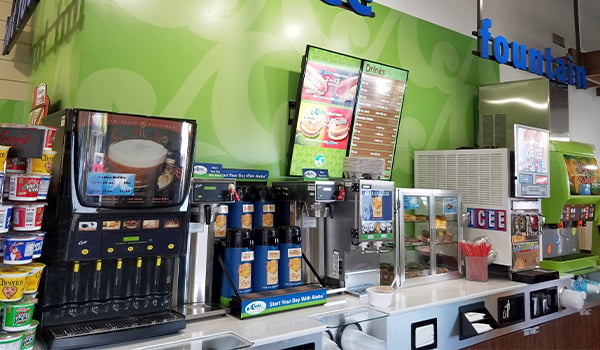Revised October 08, 2025
Pop quiz!
Is eating a lot of sugar good for you?
I am willing to bet you already know the answer to this question. If you answered “no” then you are correct. The vast majority of people over the age of 4 know the answer to this question, so why are Americans consuming nearly 50% more sugar per day than they did in the 1950s? People are now eating an average of 16 teaspoons of added sugar per day, which is 270 calories worth!
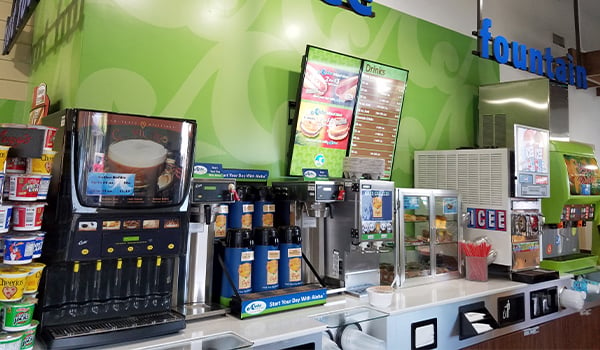
Most everyone agrees that the increase in sugar intake has led to a sea of unwanted calories and contributed to the obesity issue in our country. The Dietary Guidelines for Americans report that added sugars are consumed in excessive amounts, resulting in a high intake of calories that offer zero nutritional payback.
According to the USDA, a healthy dietary pattern limits added sugars to less than 10 percent of calories per day. The American Heart Association recommends a more ideal range of fewer than 100 calories (or 24 grams or 6 teaspoons) of added sugar per day, which would be less than 5% of total calories.
To put this in perspective, the average can of soda or fruit punch provides 150 calories, equivalent to 10 teaspoons of added sugar. If you were to drink just one can of soda every day, and change nothing else, you could gain up to 15 pounds in 3 years!
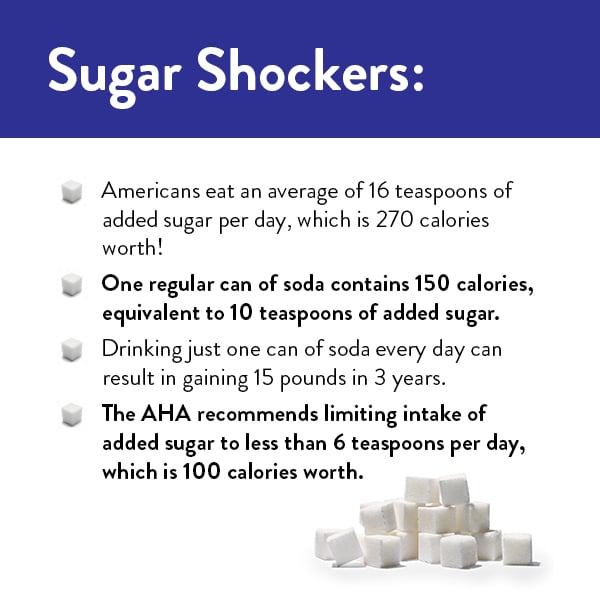
Kelly Brownell, Ph.D., director of the Yale Rudd Center for Food Policy & Obesity, sums it up: “Sugar is certainly an important culprit in the obesity problem, but it’s not the only one. Sugar is important for several reasons: It’s added to the diet in large amounts; it makes things extremely palatable so that it pushes people to over-consume it; and it’s a major source of calories, especially from sugars added to beverages.”
What’s changed since the 1950’s that sky-rocketed our sugar intake?
Back in “the good ol’ days” the number of fast-food restaurants was much lower and the size and containers for foods were much smaller. Sugar-sweetened beverages were reserved for special occasions and they were in smaller bottles. Now they’re huge and very convenient.
Undoubtedly, it’s more bang for your buck to order the “Super Size Value Meal” at the drive-thru, right? And they will throw the toy in if you order the “Kid’s Meal” which, of course, includes a sugary drink.
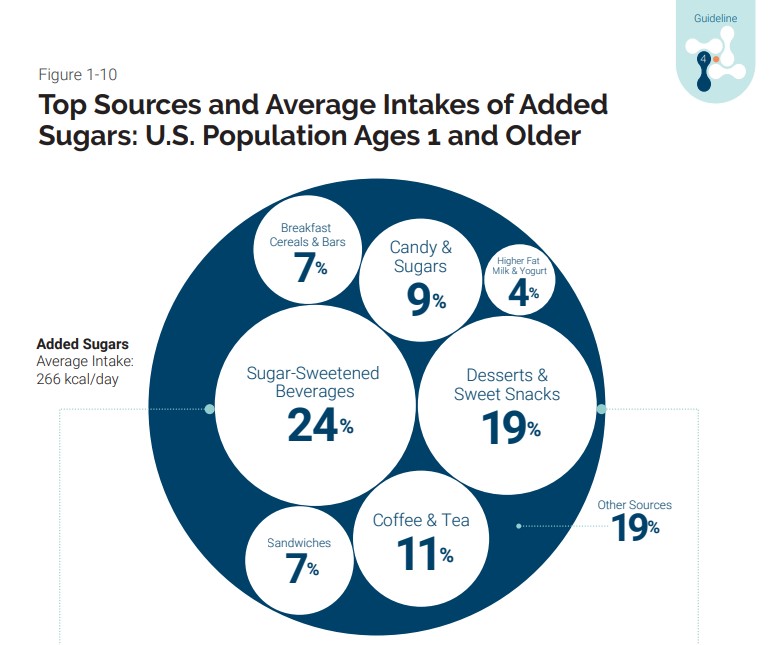
Are All Sugars Equal?
First of all, let’s remember we are only talking about added sugars. Natural sugar is found in fresh fruit, sweet potatoes, carrots, corn, sugar snap peas, unsweetened milk, plain yogurt, and unprocessed grains, and these are packed full of fiber, vitamins, and minerals. Nutritional powerhouses! The natural sugars found in whole, unprocessed carbohydrate foods are exactly where our sugar should be coming from.
It is the process of adding sugar to sweeten our foods that is the main culprit. When added sugars in foods and beverages exceed 7% of the total calories, a healthy dietary pattern within calorie limits is very difficult to achieve.
As far as the type of added sugar, research has shown that there is no difference in blood sugar levels whether consumed from white table sugar, high fructose corn syrup, or honey. The same study also showed that all three sugar sources caused a rise in triglyceride levels (a marker for heart disease).
To add to the confusion, added sugars go by many different names, yet they are all a source of extra calories and affect blood sugar similarly.
Below are some alternate names for sugar that you may see on food labels:
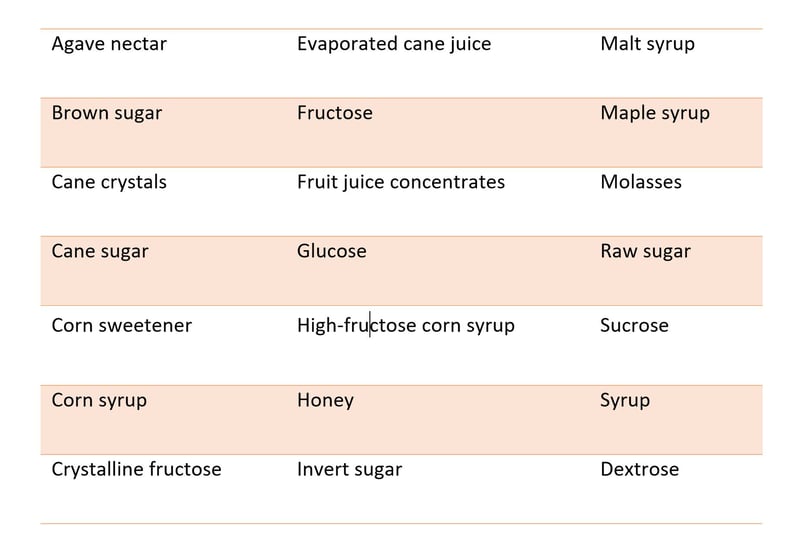
What about High Fructose Corn Syrup?
Fueling the sugar debate even further is consumer confusion over the effects of high fructose corn syrup specifically, which has received the majority of public scrutiny, even to the point where consumers often consider pure cane sugar to be healthful in comparison. However, as mentioned earlier, all added sugars, such as high fructose corn syrup, table sugar, and honey, have been shown to be similar in their effects.
The problem with high fructose corn syrup is that it’s so prevalent in our food supply. Its intake increased by more than 1,000% between 1970 and 1990 alone, far exceeding the changes in intake of any other food in the American diet. High fructose corn syrup now represents more than 40% of the caloric sweeteners added to foods and beverages and is the primary caloric sweetener in soft drinks—the top source of added sugar.
It should be noted that replacing added sugars with artificial no-calorie sweeteners may reduce caloric intake in the short term and aid in weight management initially, yet serious questions remain about their effectiveness as a long-term weight management strategy and their effect on health if used in abundance. Even natural alternative sweeteners, like monk fruit or stevia, are just making everything taste sweet and fueling your sweet tooth without any nutritional value.
The best bet is to retrain yourself to satisfy your sweet tooth with simple fresh fruit and other naturally sweet-tasting whole foods. Save the ultra-sweet treats and desserts for special occasions, and fully enjoy the exceptional treat in moderation and without feeling guilty. It is what you eat 90% of the time that will determine your health and nutritional status, so rest assured there is room for occasional sweets and treats.
The Sugary Beverage Problem:
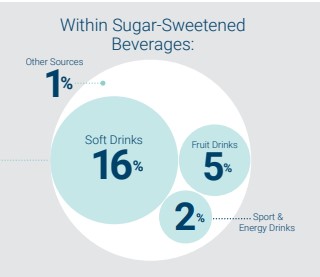
- Sugar-sweetened beverages are the #1 source of added sugar in the American diet
- They are almost completely empty calories with little nutritional value
- They are advertised and promoted heavily
- Although high in calories, they do not fill you up or compensate for calories from solid foods
- One study found that adults who drink one or more sodas every day are 27% more likely to be overweight or obese than those who don’t drink soda
- Women who regularly consume sugar-sweetened beverages were shown in one study to have a higher risk of coronary heart disease
Conclusion
The bottom line is only consume added sugars, whether from honey, maple syrup, brown sugar, white sugar, organic sugar, agave nectar, or high fructose corn syrup, in moderation. Start reading your food labels and identify where you are getting added sugars from regularly. Is it your coffee drink, sweet tea, health supplements, granola bars, candy, cereal, yogurt, protein shakes, sandwiches? You may be surprised!
It’s not an easy habit to break, but you can do it by gradually taming your sweet tooth to be satisfied with less and less sweet intensity. Essentially, the goal is to lower your sweet tolerance.
The truth is we learn to like what we are used to eating. And we get used to whatever we do over and over and over. So, retrain your taste buds to enjoy the natural sweetness that God originally provided for us— which can actually never be improved upon by man’s creations.
References:
https://www.todaysdietitian.com/newarchives/100112p28.shtml
https://www.ars.usda.gov/news-events/news/research-news/2016/the-not-so-sweet-truth-about-sugars/
https://www.hsph.harvard.edu/nutritionsource/carbohydrates/added-sugar-in-the-diet/
